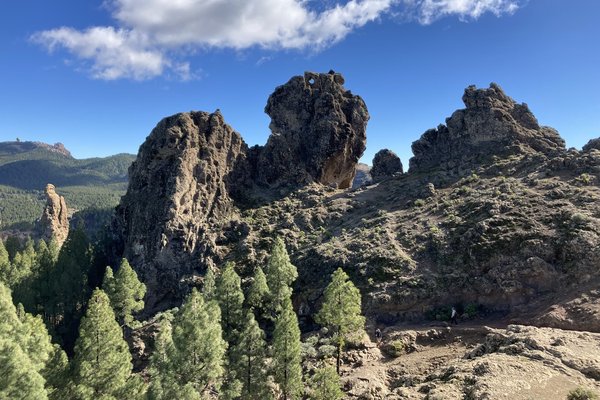Spain
Risco Caido
Risco Caido and the Sacred Mountains of Gran Canaria Cultural Landscape are testimony to the pre-Hispanic culture of the island.
This mountainous area around the Caldera de Tejeda includes a large number of troglodyte settlements, archaeological sites and rock art. The ancient Canarians, who descended from Berbers from North Africa, developed their culture in isolation until the 15th century.
Community Perspective: Solivagant and Clyde have provided invaluable information on how to visit the included components, which are scattered around the mountainous interior of Gran Canaria. Els suggests topping it up with a visit to the Canarian Museum in Las Palmas to get to know the indigenous culture.
Site Info
Official Information
- Full Name
- Risco Caido and the Sacred mountains of Gran Canaria (ID: 1578)
- Country
- Spain
- Status
-
Inscribed 2019
Site history
History of Risco Caido
- 2019: Inscribed
- Inscribed
- Type
- Cultural
- Criteria
- iii
- v
Links
- UNESCO
- whc.unesco.org
- Official
-
- riscocaido.grancanaria.com — Risco Caído y las Montañas Sagradas de Gran Canaria
- facebook.com — Official Facebook page
All Links
UNESCO.org
- whc.unesco.org — whc.unesco.org/
Official Website
- riscocaido.grancanaria.com — Risco Caído y las Montañas Sagradas de Gran Canaria
- facebook.com — Official Facebook page
News Article
- Aug. 12, 2019 edition.cnn.com — Fire in Spain's Canary Islands leaves rescuers 'fighting for our island'
Community Information
- Community Category
- Cultural Landscape: Relict
Travel Information
Not for Acrophobes
Recent Connections
-
Perfect Inscriptions
2019 -
Not for Acrophobes
Cuevas del Rey ("if you don't have a he… -
Located in a TCC Territory
Canary Islands
Connections of Risco Caido
- Geography
-
-
Volcanic plugs
Roque Nublo -
Macaronesia
Risco Caido lies on Gran Canaria, part of the Canary Islands (Spain).
-
- Trivia
-
-
Cultural sites closely connected to volcanoes
Gran Canaria is of volcanic origin, "A second cycle of volcanic eruptions, known as the "Roque Nublo cycle", took place between 4.5 and 3.4 million years ago. ... Most of the inland peaks were formed by erosion from these materials. This period also started with fissural basalts, but ended with violent eruptions of pyroclastic flows." (wiki)See en.wikipedia.org
-
- History
-
-
Berbers
The archaeological and historic testimony of the property bear out the fact that this culture stems from the original populations from the Berber Maghreb (AB ev)
-
- Ecology
-
-
Table Mountain
Mesa de Acusa
-
- Architecture
-
-
Cave dwellings
A large number of troglodyte settlements (AB ev)
-
- Damaged
-
-
Wildfires
"A mountain fire, sparked by a welder using a soldering iron, spiralled out of control in Gran Canaria, Spain, on Sunday August 11th [2019] causing mass evacuations. ... It has spread from the Artenara municipality into both Galdar and Tejeda, including the Sacred Mountains World Heritage Site and is burning through the pine forests of the Caldera de Tejeda."See 7dnews.com
-
- World Heritage Process
-
-
Perfect Inscriptions
2019
-
- Religion and Belief
-
-
Sacred Mountains
Offical name of the site is: Risco Caido and the Sacred Mountains of Gran Canaria Cultural Landscape
-
- Human Activity
-
-
Petroglyphs
Several, including "The vicinity of Roque Bentayga also contains artificial caves, defensive walls and alphabetical petroglyphs." (nom file) -
Transhumance
Transhumance routes, which clearly date from ancient times, and troglodyte cisterns, are still used by local livestock breeders (AB ev) -
Man-made Terraces
The landscape has been shaped to create unique farming terraces (AB ev) -
Erotic art
"This cavity is also richly decorated with triangular motifs, interpreted as representing the female pubic triangle as a symbol of fertility." (AB ev)
-
- Constructions
-
-
Passage of the Sun
An impressive hierophany involving an artificial cave takes place at Risco Caído (...). The main cave at this sanctuary is hollowed out with a smooth paraboloidal roof and is decorated with numerous cup-marks and pubic triangles. Between the spring equinox and the autumn equinox, morning sunlight enters the cave each day through a specially constructed opening and interacts with various of the carvings. (Chankillo Nomination Text, p. 133) -
Cisterns
troglodyte cisterns (AB ev) -
Granaries
The landscape includes former granaries
-
- WHS on Other Lists
-
-
Located in a TCC Territory
Canary Islands
-
- Timeline
-
-
Built in the 6th century
exceptional testimony to an extinct insular culture that seems to have evolved in isolation for more than 1500 years (AB ev)
-
- Science and Technology
-
-
Archaeological potential
"ICOMOS notes that, bearing in mind the recent discovery at Risco Caido, the archaeological potential in the buffer zone is promising." (AB ev) -
Astronomy and Astrology
"The sacred site of Caldera de Tejeda reveals the existence of multiple structures ... aligned with the rising and setting sun, particularly at the Summer Solstice and the Equinoxes" -
Mathematical Concepts
Parabolic
-
- Visiting conditions
-
-
Not for Acrophobes
Cuevas del Rey ("if you don't have a head for heights don't even try visiting it"), but also some of the paths to other caves can be vertigo-inducing
-
- WHS Names
-
-
Untranslated Toponyms
'Risco' means cliff in Spanish. Several riscos lie within the WHS, that is "formed of cliffs, ravines and volcanic formations".
-
News
- edition.cnn.com 08/12/2019
- Fire in Spain's Canary Islands lea…
Recent Visitors
Visitors of Risco Caido
- Adrian Turtschi
- Alberto Rodriguez Gutierrez
- Alexander Lehmann
- Atila Ege
- Bin
- bossc
- Brendan Carroll
- Bropyk
- Christoph
- Christravelblog
- Clyde
- Dan Pettigrew
- del
- Dimitar Krastev
- Dorejd
- Echwel
- Els Slots
- forest80
- George Gdanski
- Grzegorz Andruszkiewicz
- Harry Mitsidis
- Jakob F.
- janameerman
- Janina Lehmann
- Jan-Willem
- Jan Zimmermann
- Jasam
- Jay T
- Jeanne OGrady
- Lars Bogstad
- Loic Pedras
- Luis Filipe Gaspar
- Lukasz Palczewski
- Maciej Gil
- Mikko
- Nick M
- Nihal Ege
- Patrik
- PeterH
- Philipp Leu
- Philipp Peterer
- Randi Thomsen
- Rick Ohm
- Rodinia
- Roger Ourset
- Roman Bruehwiler
- sibariam
- Solivagant
- Stanislaw Warwas
- Stijn
- Svein Elias
- Szucs Tamas
- Tarquinio_Superbo
- Thomas Buechler
- Tonisan
- triath
- Vanessa Buechler
- Westwards
- Wojciech Fedoruk
- Zhenjun Liu
- Zoë Sheng
Community Reviews
Show full reviews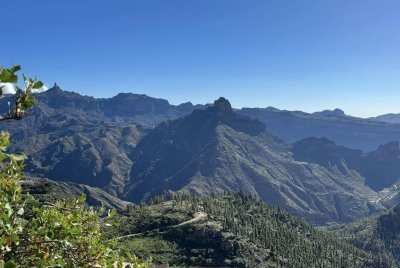
Visited in January 2024.
This object is dedicated to Guanche, original inhabitants of the islands, it is believed that they were Berbers who sailed from the lands of modern Morocco (although it is unclear how they sailed to the Canary Islands).The life of these aborigines was quite simple: they grazed sheep in the mountains, grew corn, used clay vessels, but did not own metals. They lived in caves, and this lifestyle was preserved even with the change of population until the 20th century.In the mountains of Gran Canaria, painted caves were also found, which were used for ritual purposes, since the carved triangles on the walls are recognized as symbolic vulvas, and the rituals are considered to be associated with the cult of fertility. But what they were - we can only guess, because the aboriginal population of the Canary Islands became extinct after the appearance of Europeans.One of the discovered caves is considered by scientists to be a kind of astronomical laboratory, as if the sun and the moon must have illuminated the holes in the cave differently. But again, this is just speculation.The original caves are closed to visitors, but in Artenara, a replica of the cave has been made in the visitor center, and it is a pretty cool format if the original is not available. You can also visit the ethnographic museum in the town, which shows how life in the caves has continued to our time. You can also look out over the surroundings …
Keep reading 0 comments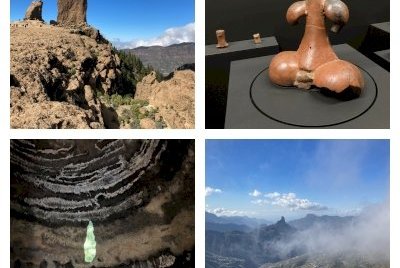
I hadn’t expected ever to visit Gran Canaria, a small Atlantic island overrun by millions of tourists yearly. But I had to secure my last World Heritage Site of Spain: I am now at 49/49. The decision to go there was made easier due to some EasyJet vouchers that I still had from Covid times. And because there's an interesting way to leave: I hopped over to Casablanca in Morocco on a tiny propeller flight.
I rented a car for 24 hours and first drove the winding roads to Roque Nublo. It was so busy that the parking lot was full already and cars were parked at the roadside for a km or so. The hike up to the main rock is only 1.5km long, but it is a tricky rocky path and I encountered a woman that had fallen and hurt her ankle (on the way back I saw her being carried away by firemen). The trail ends at a large plateau, from where you have good views of the Roque Bentayga and even Teide on Tenerife. And you get close to Roque Nublo of course, a key feature in the ‘Astronomy Skyscape’. There’s no interpretation provided here (there must be rock drawings as well but who knows where?) and all other visitors seemed to be on a family outing scrambling over rocks.
The websites of the Interpretation centers at Roque Bentayga and Artenara both say you have to contact them before visiting. I did, and …
Keep reading 0 comments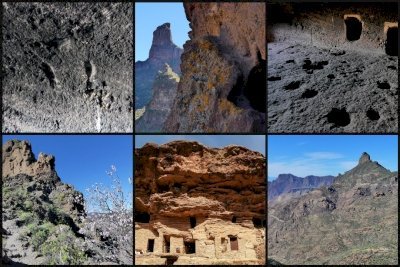
I visited this WHS in January 2020. Even though there are direct flights to Gran Canaria, I wasn't eager to spend a week on this island (even before WHS inscription). Although it is quite a big island of the Canaries, I knew I'd find the smaller ones much more interesting and to my liking.
So I opted for a fully packed return ferry trip from Tenerife (departing from Santa Cruz de Tenerife NOT Los Cristianos). With careful planning beforehand (a big thank you to Solivagant as his review was by far the best information and travel advice online about the Risco Caido WHS), I managed to follow an almost perfect loop from Agaete, up along the GC-220 road till about Juncalillo, then towards Artenara and Tejeda along the GC-21 and GC-210, going inwards to the Roque Bentayga interpretation center and Cuevas del Rey, and then following the GC-150 back to the Juncalillo point after enjoying the Roque Nublo and Pico de las Nieves viewpoints. That was the plan, so I printed out all my Google maps which turned out very handy and way better than the GPS dirt track alternatives I was given on the spot.
Just before reaching the GC-21 road to Artenara, I passed through a pine forest which had suffered extensive damage from fires in the previous years, and on the left hand side of the road (coming from Agaete's direction) I noticed a steep hill with a faded turquoise signpost marking the Zona Arqueologica …
Keep reading 0 comments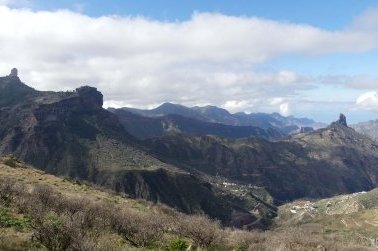
Spain’s apparent objective of gaining WHS status for all of its islands continues in 2019 with Gran Canaria (GC) - Menorca is next in line for 2022! Serendipity, rather than an obsessive chase after potential upcoming WHS, took us there for just 1 day in Jan 2019 and we fitted in a visit to the nominated site of “Risco Caido and the sacred mountains of Gran Canaria Cultural Landscape”
The Canaries (population c2.2 million) already have 3 WHS. A “colonial town” (the rather “average” San Cristobal de Laguna), “Volcanism” (Teide NP) and “relict Macronesian vegetation” (Garajonay NP). So - what could be left for other islands – a “near duplicate” of one of the former subjects? Luckily there is an, as yet unrepresented, possibility - the archaeological sites of the pre-Hispanic inhabitants of the Canaries, known as the “Guanche”! They are considered originally to have reached the Canaries from N Africa some time after 1000 BC (possibly no earlier than 500BC) and to have been of Amazigh (Berber) origin. By the time of CE they had, on each island, developed a range of different but similar cultures and appear to have remained reasonably isolated from their continental neighbours until they were invaded in 1402 by a Norman adventurer working for Castille - Jean de Béthencourt. Although they only had primitive weapons, some of the islanders put up strong resistance, and their final defeat took until 1496. Subsequently they were “ethnically …
Keep reading 0 comments
